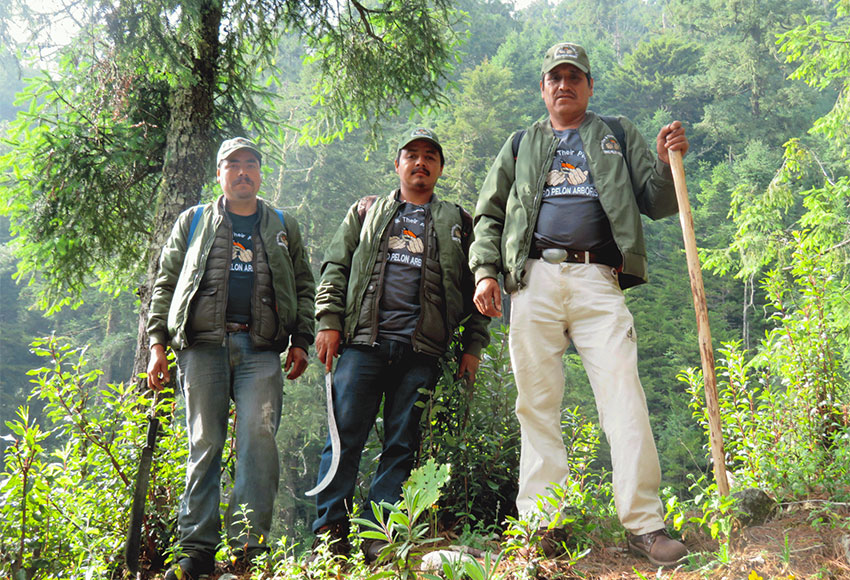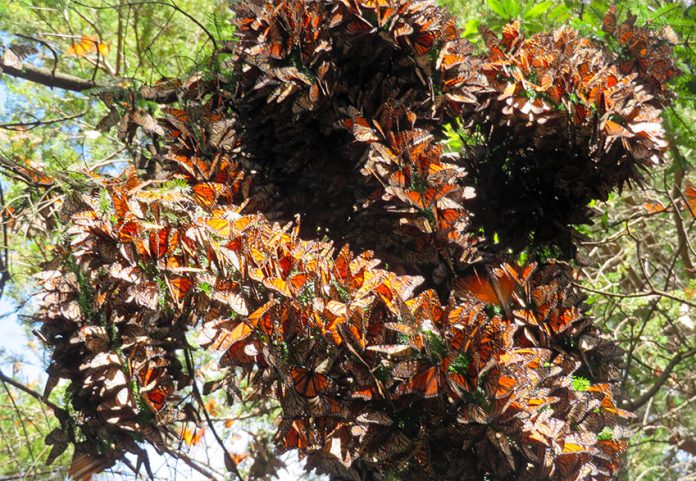While butterfly sanctuaries in México state are gearing up to open for the arrival of the monarchs in November, two sanctuaries on the butterflies’ first major stop in Mexico — and where they form their first colony of the season — will be closed to the public this year due to fears about the coronavirus pandemic.
The monarch butterflies were sighted last week in the town of Macheros, but visitors will not be allowed to enter the viewing site there, nor the one in nearby El Capulín, due to concern among officials that outsiders will bring Covid-19 to their community.
The founder of Monarch Watch, an organization dedicated to the conservation of the monarch butterflies, expressed dismay over the decision.
“The many people employed to serve the public and protect the forest in the community will surely suffer from a loss of income, and potential visitors to the area will be excluded from the wonderful, sometimes life-changing, experience of seeing the masses of monarchs on the oyamels,” Chip Taylor said. “It’s a shame.”
The annual fall migration of monarch butterflies from Canada and the United States to Mexico begins in late August or September. By November, the butterflies, after traveling up to 4,800 kilometers, have gathered in Mexico at various locations in Cerro Pelón, a 3,200-hectare federal nature reserve spanning both Michoacán and México state in the Pelón mountain range.

Because the entire Cerro Pelón sanctuary is protected, towns wishing to allow visitors to access sanctuaries in their communities must apply for a permit. This year, says Ellen Sharp, who owns JM’s Butterfly B&B in Macheros, officials declined to apply, citing coronavirus fears.
“Members of our community have been told there will be consequences if they’re caught sneaking people in,” Sharp said.
The economic effects of the closure of Macheros and El Capulín this year could also have ramifications for the monarchs’ habitat inside that part of the sanctuary, Sharp said, once locals see that the sanctuary sites are empty.
In this small, remote community of 2,000, job opportunities are scarce. Butterfly tourism has become an alternative to the illegal logging of the oyamel, pine, oak and cedar trees in the preserve. Logging threatens the butterflies’ habitat since the trees in the mountainous forest area provide a moist protective canopy that attracts the monarchs to winter there.
Macheros native and butterfly guide Ana Moreno states the issue bluntly.
“When people don’t have enough to eat, they cut down trees to sell,” she said.

Sharp, whose nonprofit Butterflies & Their People employs six “forest guardians” to patrol the Macheros area of the sanctuary for signs of both butterfly activity and logging, says the guides have already reported signs of increased logging.
Habitat loss has been a concern for monarchs internationally for decades. Urban sprawl is a factor, contributing to the loss of both habitat and food sources, as is increased mowing along roadsides even in rural areas, which all threaten milkweed, the only food monarch caterpillars eat, and pollination sources. Insect and weed control chemicals are another factor.
This summer, the Commission for Environmental Cooperation, a Canadian NGO, organized the International Monarch Monitoring Blitz, a citizen-scientist-powered count of monarch numbers, migratory habitats, and food sources in Canada, the United States and Mexico. At just 9,649 eggs, caterpillars and adults, monarch summer populations appear to be down from last year, the commission said.
The Wisconsin Department of Natural Resources said in 2019 that widespread habitat loss has resulted in monarch populations east of the Mississippi River declining 80% in the last two decades.
Beyond the effects of the pandemic on her hospitality business, with no butterfly tours available nearby this year, Sharp has already begun warning away monarch-focused customers and is refunding deposits.
She is experimenting this year with “virtual tours” of the Macheros part of the sanctuary that will start next month.
People will be able to sign up for a digital multimedia magazine updating them regularly on the monarchs’ activity beginning in November, and in February she’ll offer a daily video newsletter with footage of the monarchs during their busy month before leaving Mexico.
Part of the proceeds from the virtual tours will keep the forest guardians employed, Butterflies & Their People supervisor Patricio Moreno said.
“I hope that people will join our online experiences,” he said. “The more participants we have, the more people we can hire to help us to patrol the forest during this difficult time.”
Mexico News Daily
